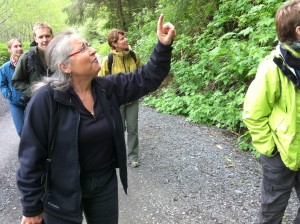
Up a staircase, through a bedroom, and there it is: a room lit by skylights and tall windows. The studio, whereTeri Rofkar weaves her work.
Rofkar was named the 2013 Rasmuson Distinguished Artist on Wednesday. The annual award is given by the Rasmuson Foundation to an Alaska artist with a history of accomplishment. It brings with it a $40,000 prize.
It is in this studio that Rofkar has shelves of books, on subjects ranging from Russians in Alaska to Tlingit ethnobotany. Bins on a low shelf hold wool.
“Mountain goat, merino, alpaca and bison, because I did use the buffalo wool for that robe for the park service, and dog,” she says. “I’m working on a dog robe.”
There’s a spinning wheel in the middle of the room and a weaving frame, on which hangs the beginning of her next project. And over on one of the shelves, right next to an elegant blue vase, is a small frame, holding the picture of a shirtless, chiseled man, smoldering at the camera lens.
“Oh, he’s just purely inspiration,” Rofkar says. “I’ve probably had him for 30 years. And he’s still inspiring. I think that’s the one thing I’ve had to frisk out of gals’ hands. Like, ‘You put that right back!’”
Of course, Rofkar’s real inspirations for her work come from all around her. Maybe it’s a story told by a family member. Or the 1964 Alaska earthquake. She calls herself a basket weaver, but much of her work is traditional Tlingit robes. Baskets, she says, big baskets that hold people.
She’s been weaving for years. Her work is often surprising — incorporating an unusual color, or a new feature, like DNA symbols woven into a recent robe she did about goats. She says finding new ways to appreciate the art is important.
Rofkar: That’s where the rubber meets the road. Are you still doing it? Does it still inspire you? Are you still excited to get in there and do the dirty work? Absolutely.
KCAW: Why?
Rofkar: There’s so many more discoveries. It’s like the ocean we haven’t explored.
KCAW: I remember interviewing you a few years back for a robe you were working on for the national park. And what I remember about that interview is you opened a door the robe was sitting in before it was unveiled and you spoke TO the robe.
Rofkar: Yes.
KCAW: I hear a lot of personification in the way you talk about your art.
Rofkar: It embodies the place, right? Maybe in that case it was a reflection of the history of the park and the place of the park. This robe over here that’s about the mountain goat on Baranof Island has the double-helix and DNA stranding. The science I’ve embedded in it — the double helix — is accurate. They are an entity, just as the materials that I harvest, the tree people and the ferns. The place that we’re at, we live here, but there are others who have been living here for many more thousands of years than us. It’s relationships.
Rofkar received her award from the Rasmuson Foundation at an event in Anchorage. She says the money will help her take some time to focus on art for the sake of art, rather than worrying about weaving things that will earn money.
“Rasmuson has such a leap of faith to support all these artists, and they’re calling it a vision,” Rofkar said. “But for us, it’s our journey. They’re making our journey possible.”
What Rofkar does is rare, but she’s working to share her artform. She’s demonstrated and taught all over the country. When she started, she says she felt like her artform was on the verge of going away.
“It seemed like such a fragile art form,” Rofkar said. “There’s very few baskets. I think Tlingit basketry was declared lost in the (19)50s. I felt like I was single handedly holding it up. The robes: there are so few of them. There’s getting to be more. But here I was feeling like the carrier of the culture. And I realize now, whoops, this basketry, this weaving, it’s been going on for thousands and thousands of years. I’m the one that’s fragile. The art will continue on.”
On the way out the door, Rofkar sits me down in front of her computer, and plays a video produced for the Rasmuson Foundation. On the screen, she’s sitting at the spinning wheel in her studio.
And as she finishes introducing herself, heavy metal music begins to play and her name zooms onto the screen in big letters. It’s a startling contrast, but as it turns out, the perfect choice by the filmmaker.
KCAW: This is not music somebody would normally associate with…
Rofkar: Spinning and weaving. I love heavy metal.
KCAW: Do you?
Rofkar: I do.
KCAW: Like who?
Rofkar: Oh, Primus…
Another surprise, from Teri Rofkar.
Ed Ronco is a reporter at KCAW in Sitka.




